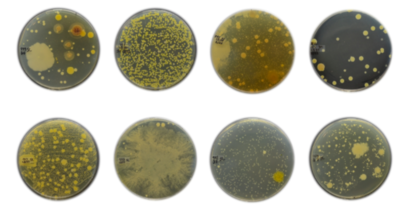User:Andreagomez-patron2020: Difference between revisions
| Line 95: | Line 95: | ||
<br>What is incredible is that within the armpit we find microorganisms that fall into categories all over the tree of life ranging from fungi, to bacteria, to viruses, and to incredibly insects! | <br>What is incredible is that within the armpit we find microorganisms that fall into categories all over the tree of life ranging from fungi, to bacteria, to viruses, and to incredibly insects! | ||
<br>Many studies and research over the years have made cultures of these microbes to study them and their roles in this specific region. In summation, we see that arguably, the most important microbial player, <i>Staphylococcus</i>, causes BO! | <br>Many studies and research over the years have made cultures of these microbes to study them and their roles in this specific region. In summation, we see that arguably, the most important microbial player, <i>Staphylococcus</i>, causes BO! | ||
<br>Looking at the three most prominent bacteria present in the armpit we find: | <br>Looking at the three most prominent bacteria present in the armpit we find: | ||
Revision as of 07:34, 11 June 2020
The Armpit!
Overview
By Andie Gomez-Patron
Armpits are a pretty well known location for most people. However, did you know that you have a whole community or microorganisms living in those pits? Armpits have similar communities to other moist areas of the human body, but with one special microbe, Staphylococcaceae, that causes a pungent odor to be released. Below we will describe why this is and how microbes interact with our armpits.
Detailed Environmental Description
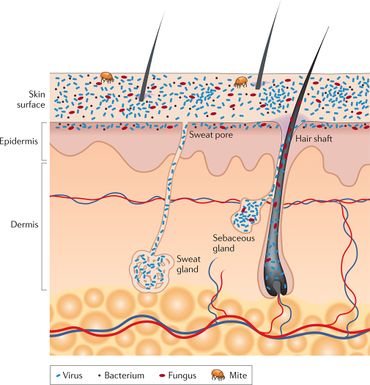
Physically, this environment is located under the arms of human beings. It is composed of human skin and provides a damp and humid environment, shielded from the sun for the majority of the time. Geochemically, this is independent of any earthly environments so it is not affected by soil or water but instead dictated by humidity, temperature, and pH. This particular environment can be described as the “moist, warm, dark, and loaded with organic matter” [2] which is great for microorganisms! When looking at pH levels in our armpits, we can see that men report ~5.8 and women ~6.0 [2]. Moreover, the environment is home to prominent hair follicles as well.
When distinguishing the armpit environment from general human skin microbiomes, scientists have distinguished three general environments in the body that populate similar microbes due to their similar environments. The categories are the oily locations, the moist locations, and the dry locations. The armpit falls into the middle category of moist locations which tends to see Corynebacterium.
[3]
This environment is easily accessed and incredibly common, making it a perfect region to be studied. The human skin environmental ecology has been studied at great lengths, in the past and currently by microbiologists and dermatologists alike.
[4]
This research is ongoing and has no shortage of studies focusing on armpit microbial communities. Currently, one study is focusing on understanding how deodorant affects the microbial diversity in armpit populations and they have already created cultures from found microbes and stated their analysis on these cultures. This is showing how chemical changes to the environment can affect the microbial ecology in this region. To the right we see an image of some of the cultures being studied within this environment.
[5]
Moreover, we can see general skin environmental analysis research being done. In the image to the left, we see how the general skin environment invites different microorganisms.
[6]
Overview of Microbial Ecology as it is known
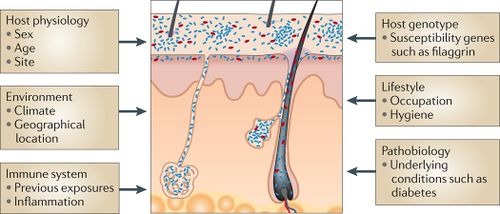
There is a large symbiosis and many commensals as well [4] between human skin and the microbes that inhabit it’s areas. Various parts of the skin house different kinds of microorganisms. On the surface of the skin we see mites inhabiting as well as bacteria and fungi, around the sweat glands we see the capability for virus housing, and around the hair follicles and entryways we see potential for viruses and prevalent fungi. [6]
However, different areas of the human body are more suited for different microbial communities and interact with each other differently. The armpits in particular, have one notable behavior that sets it aside from just any area of the body: sweat! Microbes within the armpit use “the organic sweat gland secretions as food, and as they break down these molecules, volatile odor compounds are released.” [2]
In terms of alpha and beta diversity within this armpit system, we see the alpha diversity as incredibly diverse ranging from fungi, to mites, to bacteria, to viruses, not including the specifics of each that can arise. Therefore, we see an incredible richness of species diversity. In terms of beta diversity, we see that the community abundances can change greatly depending on the different conditions of the armpit such as hygiene, moisture content, odor represents, and more.[5]
For this change in diversity abundances depending on different conditions, we look to the image on the right.[6]
Expansion topic 1: Implications to Disease/Rashes
Various diseases, infections, and rashes can occur due to the microbes living under our arms. Some of the more prevalent and scary bacterial infections that can occur in the armpits are furuncle, also known as boils. [7] We could also see Erythrasma, which is caused by Corynebacterium minutissimum, a type of bacteria. This presents itself as lesions and scales of various irritated colors.[7]
Moreover, scabies is an infection that can occur in various parts of the human body including the armpits. This forms from mites that live on the skin, specifically scabies mites, which cause a reaction since the skin is not used to the feces and proteins of the scabies mite.
Finally, we can also see fungal infections in the armpit region. One example is ringworm, which is caused by a “family of dermatophyte fungi such as Trichophyton, Microsporum, and Epidermophyton.” [8], and more specifically, Trichophyton rubrum. [9]
Expansion topic 2: Implications to Smell!
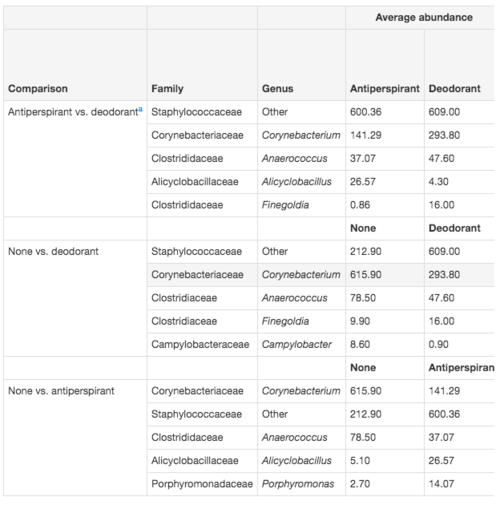
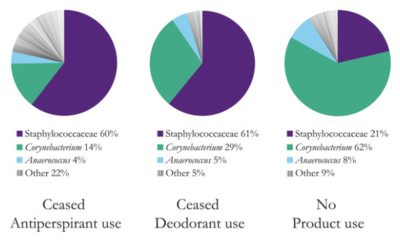
One recent study did a test comparing deodorant user armpits versus all natural armpits and found that those that do not use any kind of odor preventing substance such as antiperspirants or deodorants, have most prevalent Corynebacterium while “individuals who used antiperspirants or deodorants long-term, but who stopped using product for two or more days as part of this study, had armpit communities dominated by Staphylococcaceae.” [5] The presence of Staphylococcus hominis [10] is one of the leading and dominant factors contributing to this particular region’s pungent smell!
The image to the right shows the most prominent microbes found in each trial and their abundances in each condition.
The image to the left shows summarizes the three main user conditions, which are antiperspirant, deodorant, and no odor suppressants, and the range of their community diversity.
Key Microbial Players
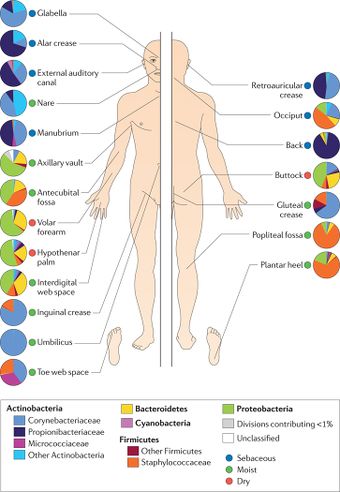
The skin has an incredible array of different microorganisms at play all over the body. Some of the most important microbial players across skin are Staphylococcus, Micrococcus, Corynebacterium, Brevibacterium, Dermabacter, and Malasezzia.[4]
When looking at the microbes in the human armpit, it is important to understand that each area of the human body provides slightly different moistures, exposure to light, pH levels, gland secretion, and other environmental factors. Therefore, while there will be some underlying similarities in some of the communities on the body, that armpit will have its own very specific key microbes. From the image [6], we can see that for the armpit (labeled “Axillary Vault”) in particular, we see a large majority of proteobacteria, and a smaller yet still important collection of bacteroidetes.
The image on the left shows pie charts of the various bacteria found in different areas of the body, including the armpit.
What is incredible is that within the armpit we find microorganisms that fall into categories all over the tree of life ranging from fungi, to bacteria, to viruses, and to incredibly insects!
Many studies and research over the years have made cultures of these microbes to study them and their roles in this specific region. In summation, we see that arguably, the most important microbial player, Staphylococcus, causes BO!
Looking at the three most prominent bacteria present in the armpit we find:
Staphylococcus
Corynebacterium
Anaerococcus
Conclusion
In summation, we can see that the armpit has a complex assortment of microorganisms that encompasses many different types of life on the phylogenetic tree. It is dominated by proteobacteria and some bacteroidetes, but can contain viruses, fungi, many bacterium, and even mites. These microbes, specifically the Staphylococcus, interact with the sweat produced within this moist environment to feed themselves and, in turn, secrete a strong odor.
References
- ↑ “Armpit Microbes.” Public Science Lab, 21 Nov. 2016,
- ↑ 2.0 2.1 2.2 Altor, Anne.: “Armpit Ecology!One Earth Body Care.” One Earth Body Care, 5 Aug. 2017.
- ↑ Akst, Jef.: “Microbes of the Skin.” The Scientist Magazine®.
- ↑ 4.0 4.1 4.2 “Microorganisms Found on the Skin.” Microorganisms Found on the Skin | DermNet NZ.
- ↑ 5.0 5.1 5.2 Urban, Julie, et al. “The Effect of Habitual and Experimental Antiperspirant and Deodorant Product Use on the Armpit Microbiome.”
- ↑ 6.0 6.1 6.2 6.3 Grice E.A. and Segre J.A. 2011. The skin microbiome. Nature Reviews Microbiology 9:244–253.
- ↑ 7.0 7.1 Brannon, Heather L. “9 Bacterial Skin Infections You Should Know About.” Verywell Health, Verywell Health, 25 Feb. 2020
- ↑ Olesen, Jacob. “Ringworm in Armpit: Causes, Symptoms and Treatment of Armpit Fungus.” Make Life Natural, 5 Mar. 2019
- ↑ Society, Microbiology. “Microbes and Disease: Microbes and the Human Body.” Microbes and the Human Body | Microbiology Society
- ↑ Rutsch, Poncie. “Meet The Bacteria That Make A Stink In Your Pits.” NPR, NPR, 31 Mar. 2015
Authored for Earth 373 Microbial Ecology, taught by Magdalena Osburn, 2020, NU Earth Page.
